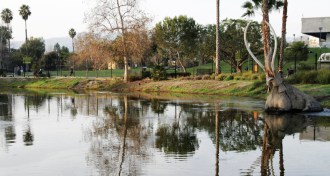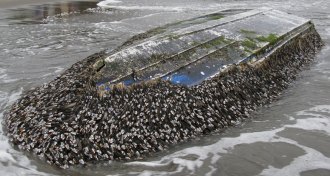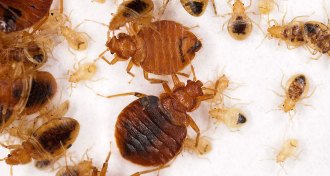Animals
-
 Animals
AnimalsSurgeon aims to diagnose deformities of extinct saber-toothed cats
Using CT scans, one orthopedic surgeon is on a quest to diagnose deformities in long-dead saber-toothed cats.
-
 Animals
AnimalsNew deep-sea sponge could play a starring role in monitoring ocean health
A new species of sponge that dwells on metal-rich rocks could help scientists track the environmental impact of deep-sea mining.
-
 Animals
AnimalsAncient whale turns up on wrong side of the world
A Southern Hemisphere whale species was briefly a northern resident.
-
 Agriculture
AgricultureMuch of the world’s honey now contains bee-harming pesticides
A controversial group of chemicals called neonicotinoids has a global impact, tests of honey samples show.
-
 Paleontology
PaleontologyA baby ichthyosaur’s last meal revealed
A new look at an old fossil shows that some species of baby ichthyosaurs may have dined on squid.
-
 Paleontology
PaleontologyA baby ichthyosaur’s last meal revealed
A new look at an old fossil shows that some species of baby ichthyosaurs may have dined on squid.
-
 Oceans
OceansCastaway critters rafted to U.S. shores aboard Japan tsunami debris
Researchers report finding 289 living Japanese marine species that washed up on American shores on debris from the 2011 East Japan earthquake and tsunami.
-
 Animals
AnimalsBedbugs may be into dirty laundry
When humans aren’t around, bedbugs go for the next best thing: smelly human laundry.
-
 Paleontology
PaleontologyThis giant marsupial was a seasonal migrant
A new analysis suggests that Diprotodon optatum, a giant plant-eating marsupial that went extinct about 40,000 years ago, migrated long distances, much like today’s zebras and wildebeests.
-
 Paleontology
PaleontologyThis giant marsupial was a seasonal migrant
The giant, extinct marsupial Diprotodon optatum migrated seasonally, the first marsupial shown to do so.
-
 Animals
AnimalsTo test sleep, researchers don’t let sleeping jellyfish lie
Upside-down jellyfish are the first known animals without a brain to enter a sleeplike state.
-
 Health & Medicine
Health & MedicineFrom day one, a frog’s developing brain is calling the shots
Frog brains help organize muscle and nerve patterns early in development.